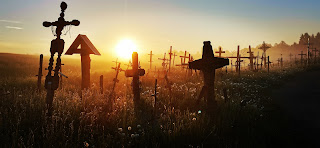The crosses on the Hill were first mentioned in written chronicles in 1850, but it is believed that the first crosses were put by the relatives of the victims of the rebellion in 1831 as the tsarists government did not allow the families to honor their dead properly. Crosses of the kind became more numerous after the other rebellion in 1863.
In the beginning of the 20th century the Hill of Crosses was already widely known as a sacral place. In addition to many pilgrims visiting, it was also a place for Masses and devotions. The Hill of Crosses became of special importance during Soviet times – this was the place of anonymous but surprising persistence to the regime. The Soviet government considered the crosses and the hill a hostile and harmful symbol. In 1961 wooden crosses were broken and burnt, metal ones used as scrap metal and stone and concrete crosses were broken and buried. The hill itself was many times destroyed with bulldozers. During the 1973–1975 period about half a thousand crosses used to be demolished each year without even trying to do this secretly. Later the tactics became more subtle: crosses were demolished as having no artistic value, different “epidemics” were announced forbidding people to come into the region or the roads were blocked by police. The Hill was guarded by both the Soviet army and KGB. In 1978 and 1979 there were some attempts to flood the territory. Despite all these endeavors to stop people from visiting the Hill, crosses would reappear after each night.
After the political change in 1988 the status of the Hill of Crosses changed completely – it became both a Lithuanian and a world phenomenon. It gained a world wide fame after the visit of the Pope John Paul II on September 7, 1993. The Pope was extremely touched by the cross with the prayer for his health after the attempt upon his life in 1981. In his sermon during the Holy Mass his Eminence said: “Sons and daughters of your country have been carrying to this Hill crosses, akin to that of Golgotha, which saw our Saviour's death. Thus people have declared their sincere belief that their deceased brothers and sisters “have found Eternity” (…). Cross is a symbol of eternal life in God”.
In 1997 the Church revived devotions on the Hill. They take place every year on the last but one Sunday of July. Nowadays the Hill of Crosses is under the patronage of Šiauliai diocese, established on the 28 th oh May, 1997, and its first bishop Eugenijus Bartulis.
"The Hill of Crosses is a sacred place in the Šiauliai region with especially vast spaces for meditations of faith and manifestations of one,s love to God. It is here that Lithuania has passed through Golgotha, its people have experienced so much pain and misfortunes. Namely here revives the sincerest belief in our Saviour's sacrifice, love finds response in one,s heart, hopes become stronger. “For God so loved the world, that he gave his only Son, that whosoever believe in him should not perish, but have eternal life” (Jn 3, 16). Cross is a symbol of such Love."
The excursion can be combined with a visit to Rundale Palace the most significant baroque palace in Baltic States. It was built for the Duke of Courland E.J.Biron by the design of the architect F.B.Rastrelli in 18th century. Also the Bauska medieval Castle is on the way back to Riga. Another option is turn to Žagare town - the former capital of Litvaks (Lithuanian Jews). There are still preserved Old Jewish cemeteries, the estate of princes Zubov and Naryshkin and the so -called House of Pans. There is also a cafe that serves delicious zeppelins, the national Lithuanian dish. For more information and reservations write to Watsapp or Viber or SMS:+371 29218560 or e-mail:dotrips@gmail.com
Publication on National Geographic here https://www.nationalgeographic.com/travel/article/things-to-do-hill-of-crosses-religious-tourism
Publication on Lonley Planet here https://www.lonelyplanet.com/lithuania/central-lithuania/siauliai/attractions/hill-of-crosses/a/poi-sig/1085557/360110
Publication on BBC Travel here https://www.bbc.com/travel/article/20171026-lithuanias-miraculous-hill-of-100000-crosses
Publication on Atlass Obscura here https://www.atlasobscura.com/places/hill-of-crosses
Publication on Nova Monde here https://www.novo-monde.com/en/hill-of-crosses-lithuania/
More photos of Hill of Crosses on https://www.shutterstock.com/search/hill-of-crosses%2C-lithuania?image_type=photo
For more information and reservations write to Watsapp or Viber or SMS:+371 29218560 or e-mail:dotrips@gmail.com










Šo komentāru ir noņēmis autors.
AtbildētDzēst